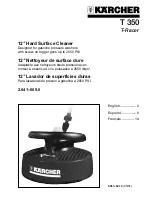
24
EN
Golden rules when pressure cooking
(for UK Consumers)
• The minimum quantity of liquid required for normal cooking is 250 ml (½
pint) for the first ¼ hour cooking. For each additional ¼ hour, or part of ¼
hour, add a further 150 ml (¼ pint) of liquid. For example, 45 minutes
cooking requires 600 ml (1 pint) of liquid. Note: This is only a general guide.
Certain foods, such as rice, pulses, steamed puddings and Christmas
puddings may require extra water (see text below).
• When steaming foods in the basket* use a minimum of 750 ml (1¼ pint)
water in the cooker.
• Always use a liquid that gives off steam when boiled e.g. water stock, wine,
beer or cider. Never use oil or fat. All pressure cooking requires some liquid.
• Whatever the size of pressure cooker, the maximum filling level when all the
ingredients and liquid have been added are:
Solid foods e.g. vegetables, meat joints:
no more than two-thirds full
Liquids and cereals e.g. soups, stews, rice, cereal and pasta:
no more than
half full
Pulses e.g. dried beans and dried peas:
no more than one-third full
• When cooking pulses they swell up and tend to froth up. Use 1.2 litres (2
pints) water for every 450 g (1 lb) pre-soaked weight of pulses. Remember
all dried peas and dried beans, must be soaked in boiling water for 1 hour
before cooking. Drain, rinse thoroughly and cook in fresh water. Never eat
uncooked beans or peas. Soaking is not necessary for red lentils. The high
temperatures achieved in the pressure cooker ensure that any natural toxins
in the pulses are destroyed. Canned beans and pulses can simply be drained
and rinsed before adding to the pressure cooker.
Problems
Recommendations
If food has burned in
the pressure cooker:
Leave the pan to soak before cleaning it.
Never use bleach or products containing chlorine.
If one of the
overpressure safety
systems is triggered:
Turn off the heat source.
Let the pressure cooker cool down without moving it.
Wait for the pressure indicator to drop and open
the pressure cooker. (refer to section “Opening ”).
Check and clean the operating valve, the steam
outlet, the safety valve and the seal.
If the problem persists, contact the Customer
Relations Helpline.
*depending on model
















































